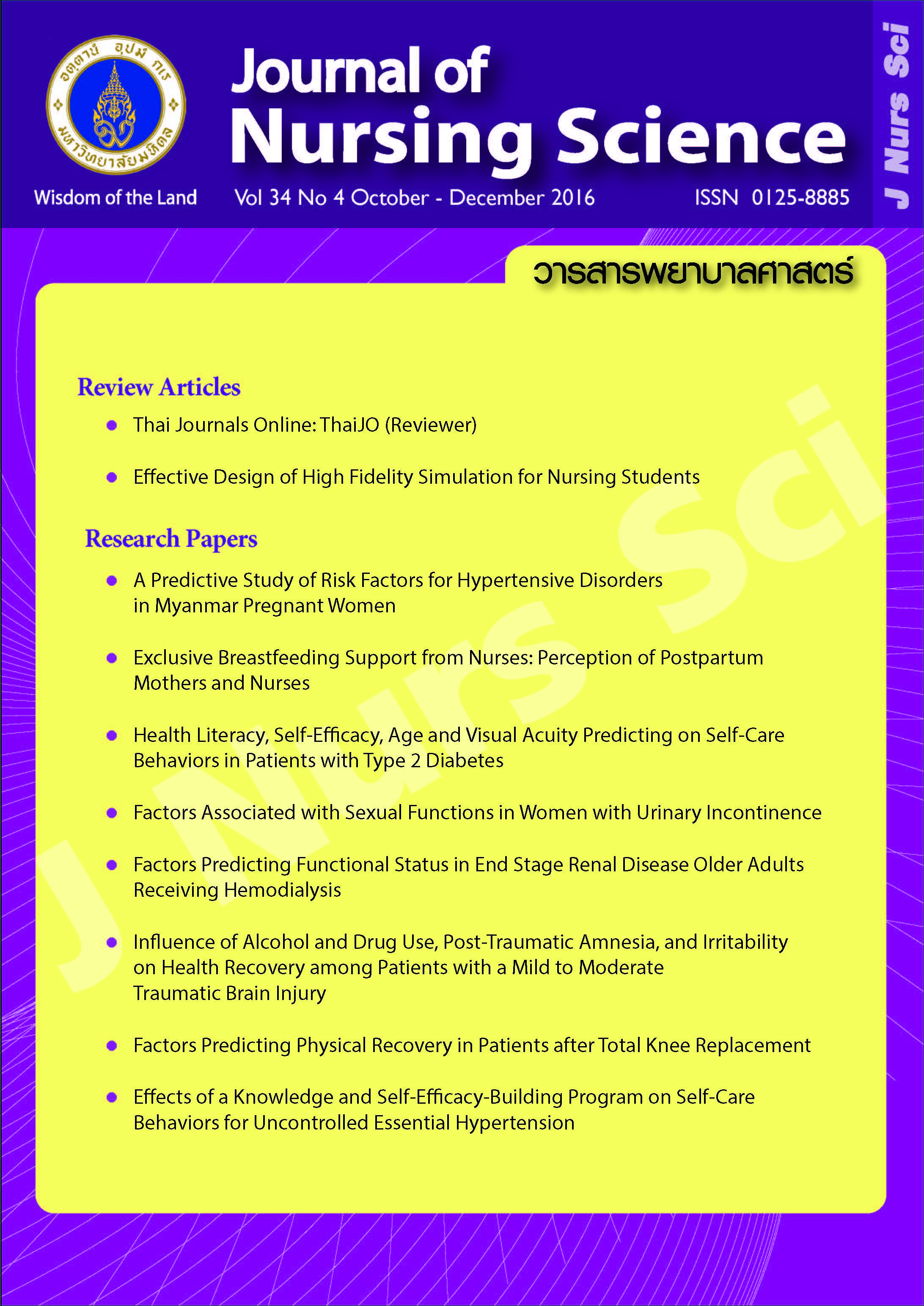Factors Predicting Physical Recovery in Patients after Total Knee Replacement
Main Article Content
Abstract
Abstract
Purpose: The aim of this study was to explore factors predicting of physical recovery: body mass index, severity of symptom and social support in patients after total knee replacement.
Design: Correlation predictive study.
Methods: The participant consisted of 95 patients with knee osteoarthritis underwent primary total knee replacement. Data were collected before surgery by personal information record form, social support, and symptom severity questionnaire and before discharge measure physical recovery by Time Up and Go test (TUG). Descriptive statistics and multiple regression were used for data analysis.
Main findings: The mean physical recovery was 94.56 second (SD = 25.69). Physical recovery, body mass index, symptom severity, and social support were accounted for 24% of variance of postoperative physical recovery in patient underwent total knee replacement (R2 = .24, F = 9.56, p < .05). Particularly body mass index is significantly predicted postoperative physical recovery (β = .484, p < .05).
Conclusion and Recommendations: The findings showed that body mass index was significance predictor of physical recovery after surgery. Therefore, weight control before surgery is the crucial nursing care in preoperative period.
ปัจจัยทำนายการฟื้นตัวด้านสรีระของผู้ป่วยหลังผ่าตัดเปลี่ยนข้อเข่าเทียม
บทคัดย่อ
วัตถุประสงค์: เพื่อศึกษาอำนาจการทำนายของดัชนีมวลกาย ความรุนแรงของอาการ และการสนับสนุนทางสังคมกับการฟื้นตัวด้านสรีระของผู้ป่วยหลังผ่าตัดเปลี่ยนข้อเข่าเทียม
รูปแบบการวิจัย: การศึกษาความสัมพันธ์เชิงทำนาย (correlation predictive study)
วิธีดำเนินการวิจัย: กลุ่มตัวอย่างเป็นผู้ป่วยข้อเข่าเสื่อมที่เข้ารับการรักษาด้วยการผ่าตัดเปลี่ยน
ข้อเข่าเทียมเป็นครั้งแรก คัดเลือกกลุ่มตัวอย่างตามเกณฑ์ที่กำหนดจำนวน 95 คน รวบรวมข้อมูลก่อนผ่าตัดโดยใช้แบบสอบถามข้อมูลส่วนบุคคล แบบสอบถามความรุนแรงของอาการ แบบสอบถามการสนับสนุนทางสังคม และประเมินการฟื้นตัวด้านสรีระหลังผ่าตัดด้วยวิธีทดสอบการทรงตัว และการเดินก่อนจำหน่ายออกจากโรงพยาบาล วิเคราะห์ข้อมูลด้วยสถิติการวิเคราะห์ถดถอยเชิงพหุ
ผลการวิจัย: กลุ่มตัวอย่างมีการฟื้นตัวด้านสรีระซึ่งทดสอบด้วยการทรงตัว และการเดินระยะเวลาที่ใช้มีค่าเฉลี่ย 94.56 วินาที (SD = 25.69) ดัชนีมวลกาย ความรุนแรงของอาการ และการสนับสนุนทางสังคมสามารถร่วมกันทำนายการฟื้นตัวด้านสรีระ ร้อยละ 24 (R2 = .24, F = 9.56, p < .05) โดยดัชนีมวลกายเป็นตัวแปรเพียงตัวเดียวที่สามารถทำนายการฟื้นตัวด้านสรีระของผู้ป่วยหลังผ่าตัดเปลี่ยนข้อเข่าเทียมได้อย่างมีนัยสำคัญทางสถิติ (β = .484, p < .05).
สรุปและข้อเสนอแนะ: จากผลการวิจัย พบว่า ดัชนีมวลกายเป็นปัจจัยที่สามารถทำนายการฟื้นตัวด้านสรีระของผู้ป่วยหลังผ่าตัดเปลี่ยนข้อเข่าเทียม ดังนั้นการควบคุมดัชนีมวลกายก่อนผ่าตัดจึงมีความสำคัญเพื่อการฟื้นตัวสำหรับผู้ป่วยข้อเข่าเสื่อมที่จะได้รับการผ่าตัดเปลี่ยนข้อเข่าเทียม
คำสำคัญ: การฟื้นตัวด้านสรีระ การผ่าตัดเปลี่ยนข้อเข่าเทียม ดัชนีมวลกาย การสนับสนุนทางสังคม ความรุนแรงของอาการ
Article Details
Copyright Notice: Nursing Science Journal of Thailand has exclusive rights to publish and distribute the manuscript and all contents therein. Without the journal’s permission, the dissemination of the manuscript in another journal or online, and the reproduction of the manuscript for non-educational purpose are prohibited.

Disclaimer: The opinion expressed and figures provided in this journal, NSJT, are the sole responsibility of the authors. The editorial board bears no responsibility in this regard.

